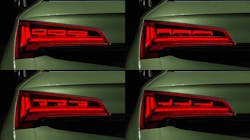Are you tired of showing the same old tail light from the rear of your car? Would you like to spice things up — maybe even put on a bit of a display and change the look as your mood suits?
Then German carmaker Audi has something for you. Using OLED technology, it is now offering a tail-light option on its Q5 luxury SUV that allow motorists a choice of different light patterns, or what Audi calls “signatures.”
While it feels a bit like a technology in search of a market, the high-end feature will probably appeal to a niche segment of buyers with money to spare and with an inclination for leading-edge technology flash. That, in turn, could trickle down to more mainstream use.
And the feature is not simply cosmetic. It has practical applications as well. For examples, sensors on the rear of a stationary Q5 will detect when an approaching vehicle gets too close, and will set the OLED lights to sudden full brightness. Audi is also considering warning symbols for conditions such as slippery roads or traffic jams.
Rochester, NY-based OLEDworks is believed to be supplying the OLEDs.
As a quick review, OLEDs (organic light-emitting diodes) are different from LEDs in that OLEDs are a thin material that entirely lights up in response to an electric charge. LEDs are single light points. OLEDs have long failed to live up to the expectation that they will revolutionize lighting by literally weaving into the fabric of everything from lamps and fixtures to ceilings, walls, furniture, fashion, building facades and you name it. But they are declining in price, improving in efficiency and slowly creeping into general illumination while also finding niche and architectural design uses.
Audi calls the tail-light technology “digital OLED,” which is something of a confusing moniker since OLEDs already are digital. Audi’s “digital” denotes a digitally-controlled unit which houses three distinct panels each with six sub-panels. The system exploits the 18 segments to deliver different programmable looks, making use of OLED’s ability to dim and to offer high contrasts of light and dark.
“The tail lights turn into a kind of display on the outer shell, which will provide us with ample opportunities and prospects in terms of design, personalization, communication, and safety,” said Audi OLED technology project manager Werner Thomas.
The OLEDs are only 1 mm thick and require no reflectors or optics. Audi said conventional LED solutions require depths of 20‒30 mm.
Audi has been offering OLED tail lights on some models since 2016. At one point, Germany’s Osram was providing the OLEDs, but Osram has been backing out of the OLED business.
OLEDworks entered into an agreement with Audi in the spring of 2019 to develop OLED technology.
Neither company has confirmed for LEDs Magazine that OLEDworks is the supplier for the Q5. But OLEDworks recently posted two short videos on its website featuring Audi head of rear lamp development Michael Kruppa, in which Kruppa refers to “digital OLEDs.”
OLEDworks was founded in 2010 by scientists who had worked for Eastman Kodak, which invented OLEDs in 1987. It acquired the Philips Lumiblade OLED operations of Signify — then called Philips Lighting — in 2015, including operations in Aachen, Germany.
MARK HALPER is a contributing editor for LEDs Magazine, and an energy, technology, and business journalist ([email protected]).
For up-to-the-minute LED and SSL updates, why not follow us on Twitter? You’ll find curated content and commentary, as well as information on industry events, webcasts, and surveys on our LinkedIn Company Page and our Facebook page.





